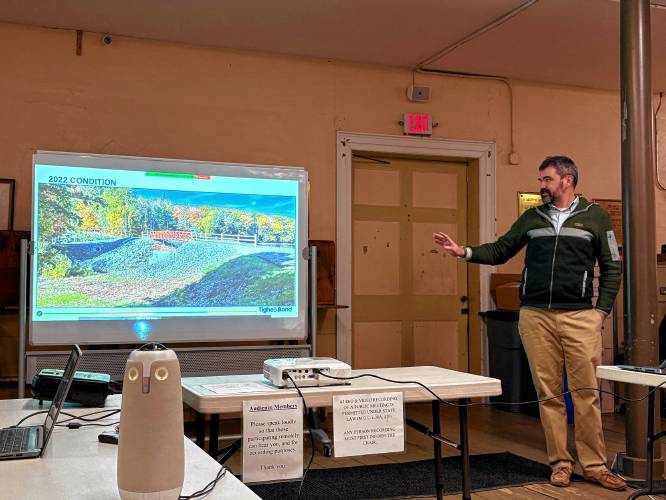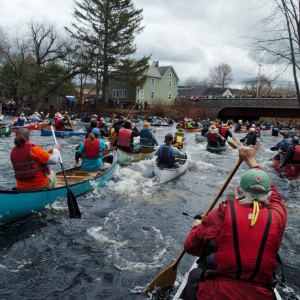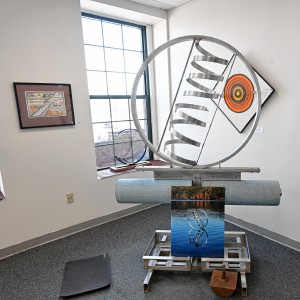One-year study proposed for Ashfield Lake Dam to control invasive species
| Published: 02-22-2025 2:06 PM |
ASHFIELD — Tighe & Bond engineers are proposing the town take on a year-long study of the effectiveness of different methods to control the buildup of vegetation and invasive species on the Ashfield Lake Dam.
The proposed study would split the dam into four plots looking at three different vegetation removal methods. In addition to one control plot, the other three areas would try out the methods of smothering, herbicides, and hand pulling and burning. The goal is to identify the best way to remove the buildup of vegetation on the dam to allow for inspections and maintenance.
“We’re proposing a one-year study of a few different options, both looking at their effectiveness of controlling plants and the practicality of their application,” Tighe & Bond engineer Lucas Acaba said during a presentation at Town Hall on Thursday. “At the end of that one year, we can look back and make a decision on a suitable long-term management strategy.”
The Ashfield Lake Dam was first constructed in the early 1800s and has been repaired and rehabilitated over the centuries after floods and breaches, according to dam keeper Ron Coler. The dam saw a major rehabilitation project in 1989, and in 2022, the town spent more than $1 million on repairs. Lack of maintenance led to costly repair projects.
To prevent further large-scale repairs, the town must control the buildup of vegetation to allow for proper dam maintenance.
“The last time there was major work done on the dam was in the late ’80s, early ’90s, over 30 years ago,” Coler said. “Maybe if we had stayed on top of that maintenance that 30 years could have been 60 years. There’s a cost associated with doing nothing.”
Tighe & Bond engineer Daniel Buttrick said the dam has a buildup of two invasive species, Asiatic bittersweet and Virginia creeper, on the riprap. The riprap is a layer of large stones on the slope of the dam that protects it from erosion.
Under Massachusetts Office of Dam Safety regulations, dams must be inspected every two years. The last time the Ashfield Lake Dam was inspected was in the spring of 2023, meaning this year is an inspection year. However, the buildup of vegetation on the riprap makes it difficult for engineers to properly inspect the dam, and the vegetation itself is difficult to remove.
Article continues after...
Yesterday's Most Read Articles
“Unfortunately, bittersweet has a tendency to grow back vigorously if it’s just cut,” Acaba said.
Plot 1 would test the effectiveness of herbicide treatments. Acaba said the selected area is 250 feet away from the beach and on a section of the dam where the slope faces away from the lake. There would need to be two rounds of herbicide application, one in the summer and one during early fall, and the town would need to look at products approved for use near aquatic areas.
At the second plot, located just east of the spillway, Tighe & Bond is proposing the town test smothering the vegetation. This would involve cutting down the vegetation and then tightly covering it with a thick rubber pool liner. Acaba said after three to five years of no sunlight, the plants die out.
“If you leave it there for multiple growing seasons, it eventually dies out,” Acaba explained.
Plot 3 would test a combination of hand pulling and burning methods at the section of the dam located adjacent to the beach. Crews will walk along the dam cutting and pulling out the plants the best they can before going in with a round of torches. If cut and burned every two weeks during the summer, the plants should die.
Plot 4, located west of the spillway, would serve as the control plot. No vegetation removal methods would be used as this spot, allowing the town to compare the different methods against what the dam would look with no human interference.
During Thursday’s presentation, Coler said he was not prepared to share the estimated cost of the study. He needs to get more quotes and finalize numbers before the proposal is officially brought to the Selectboard.
Coler said he plans to officially propose the study to the Selectboard and Finance Committee as part of his annual budget request for the dam on March 3. If endorsed by the boards, the study would then need to be approved by Annual Town Meeting voters as part of the yearly budget, and granted a permit by the Conservation Commission.
Coler hopes the study is approved so the town can proceed with removing overgrown vegetation and maintaining the dam, helping to ensure it will last into the centuries to come.
“The mission is to find a sustainable solution,” Coler said. “Every year we don’t deal with it, the roots grow deeper.”
Reach Madison Schofield at 413-930-4579 or mschofield@recorder.com.









 Literacy Project celebrating 40 years of education
Literacy Project celebrating 40 years of education River Rat Race returns for 60th year on April 12
River Rat Race returns for 60th year on April 12 Backyard Oasis, connecting older adults with podcasts, celebrates 50 episodes
Backyard Oasis, connecting older adults with podcasts, celebrates 50 episodes Stage on Main exhibit displays Athol resident’s work through the decades
Stage on Main exhibit displays Athol resident’s work through the decades
